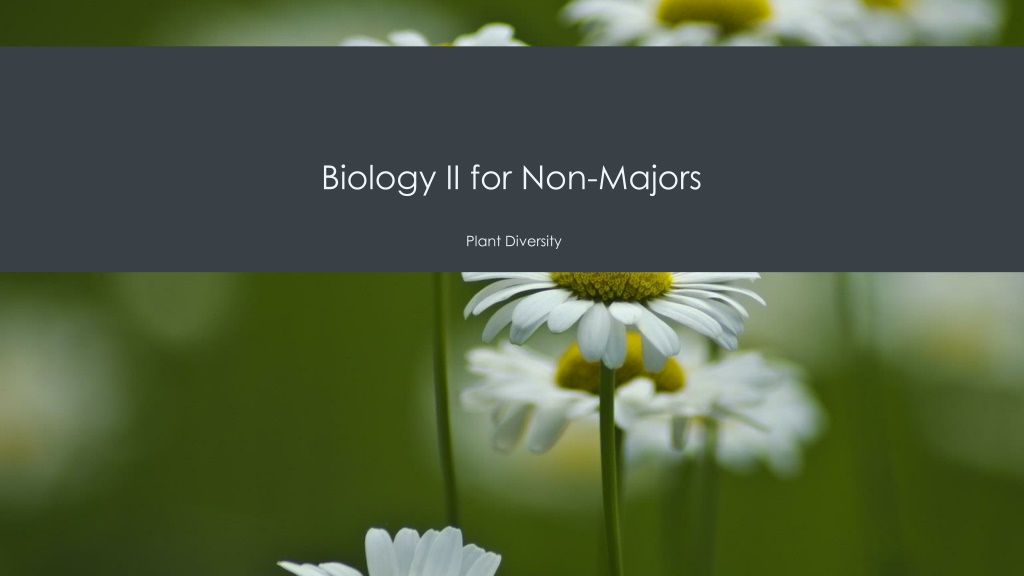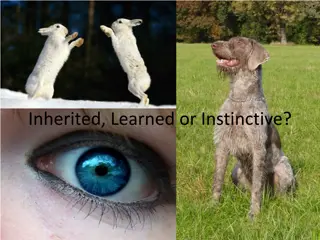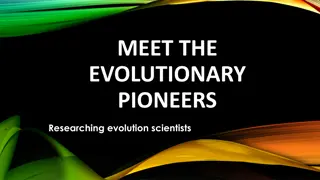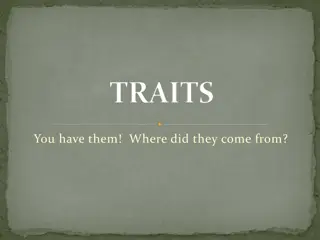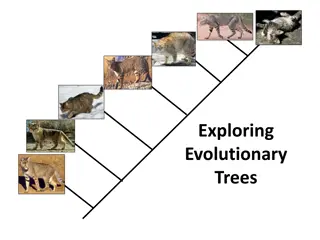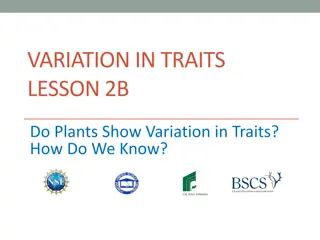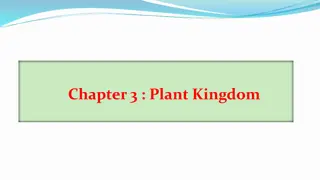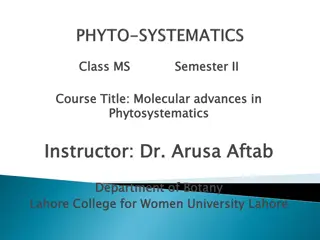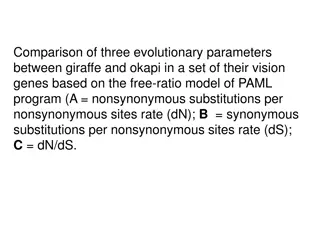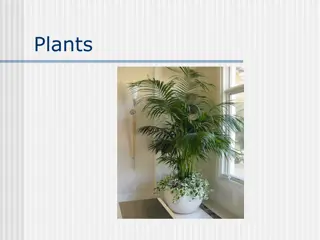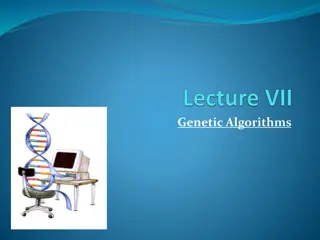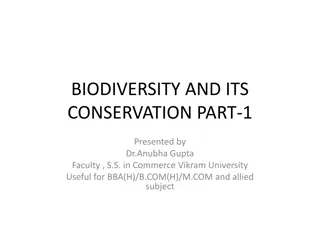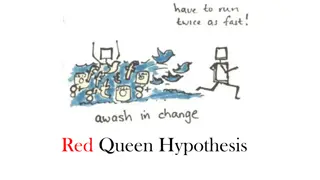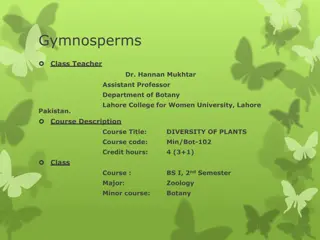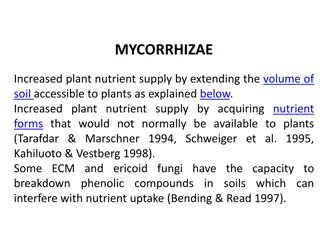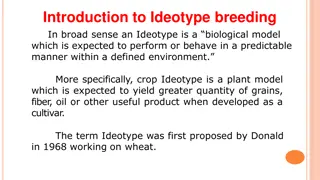Understanding Plant Diversity through Evolutionary Traits
Explore the fascinating world of land plants' evolution, from their appearance in the Ordovician period to the development of key traits such as alternation of generations, sporangia, gametangia, apical meristem, and other adaptations enabling them to thrive on land. Discover how plants have adapted over 500 million years to colonize diverse environments successfully.
Download Presentation

Please find below an Image/Link to download the presentation.
The content on the website is provided AS IS for your information and personal use only. It may not be sold, licensed, or shared on other websites without obtaining consent from the author. Download presentation by click this link. If you encounter any issues during the download, it is possible that the publisher has removed the file from their server.
E N D
Presentation Transcript
Biology II for Non-Majors Plant Diversity
Traits of Land Plants Land plants acquired traits that made it possible to colonize land and survive out of the water. All land plants share the following characteristics: the alternation of generations, a sporangium in which the spores are formed a gametangium that produces haploid cells apical meristem tissue in roots and shoots Land plants appeared about 500 million years ago in the Ordovician period.
Sporangia The sporophyte of seedless plants is diploid and results from syngamy (fusion) of two gametes. The sporophyte bears the sporangia: organs that first appeared in the land plants. Inside the multicellular sporangia, the diploid sporocytes, or mother cells, produce haploid spores by meiosis. The spores are later released by the sporangia and disperse in the environment.
Gametangia Gametangia (singular, gametangium) are structures observed on multicellular haploid gametophytes. In the gametangia, precursor cells give rise to gametes by mitosis. The male gametangium (antheridium) releases sperm. Many seedless plants produce sperm equipped with flagella that enable them to swim in a moist environment to the archegonia: the female gametangium. The embryo develops inside the archegonium as the sporophyte.
Apical Meristem in Shoots and Roots Shoots and roots of plants increase in length through rapid cell division in a tissue called the apical meristem, which is a small zone of cells found at the shoot tip or root tip. The apical meristem is made of undifferentiated cells that continue to proliferate throughout the life of the plant. Meristematic cells give rise to all the specialized tissues of the organism. Elongation of the shoots and roots allows a plant to access additional light, water, and minerals.
Other Land Plant Adaptations A waxy, waterproof cover called a cuticle protects the leaves and stems from desiccation. However, the cuticle also prevents intake of carbon dioxide needed for the synthesis of carbohydrates through photosynthesis. To overcome this, stomata or pores that open and close to regulate traffic of gases and water vapor appeared in plants as they moved away from moist environments into drier habitats. Plants evolved biosynthetic pathways to make protective flavonoids and other compounds: pigments that absorb UV wavelengths of light and protect the aerial parts of plants from photodynamic damage.
Plants Coevolved with Animals Plants synthesize poisonous secondary metabolites to discourage predation. Plants developed sweet and nutritious metabolites (i.e. fruit, nectar) to lure animals into providing valuable assistance in dispersing pollen grains, fruit, or seeds.
Plant Precursors Green algae and land plants share many features, including pigment molecules, carbohydrate storage as starch, and phragmoplasts. Consequently, land plants and closely related green algae are now part of a new monophyletic group called Streptophyta.
Non-vascular Plants Seedless nonvascular plants are small, having the gametophyte as the dominant stage of the lifecycle. Without a vascular system and roots, they absorb water and nutrients on all their exposed surfaces. Collectively known as bryophytes, the three main groups include the liverworts (right), the hornworts, and the mosses.
Liverworts Liverworts are the most primitive plants and are closely related to the first land plants.
Hornworts Hornworts developed stomata and possess a single chloroplast per cell.
Hornwort Life Cycle
Mosses Mosses have simple conductive cells and are attached to the substrate by rhizoids. They colonize harsh habitats and can regain moisture after drying out. The moss sporangium is a complex structure that allows release of spores away from the parent plant.
Vascular Plants In order for plants to evolve larger forms, the evolution of vascular tissue for the distribution of water and solutes was a prerequisite. The vascular system contains xylem and phloem tissues. Xylem conducts water and minerals absorbed from the soil up to the shoot, while phloem transports food derived from photosynthesis throughout the entire plant. A root system evolved to take up water and minerals from the soil, and to anchor the increasingly taller shoot in the soil.
Vascular Plants: Xylem Xylem tissue transports water and minerals.
Phloem Phloem tissue transports sugars and proteins.
Roots Roots, with their prominent vascular tissue system, transfer water and minerals from the soil to the rest of the plant. The extensive network of roots that penetrates deep into the soil to reach sources of water also stabilizes trees by acting as a ballast or anchor. The majority of roots establish a symbiotic relationship with fungi, forming mycorrhizae, which benefit the plant by greatly increasing the surface area for absorption of water and soil minerals and nutrients.
Leaves Leaves act as large photosynthetic organs. Small uncomplicated leaves are microphylls. Large leaves with vein patterns are megaphylls. Modified leaves that bear sporangia are sporophylls. Some sporophylls are arranged in cone structures called strobili, below.
Seedless Vascular Plants The seedless vascular plants include club mosses, which are the most primitive; whisk ferns, which lost leaves and roots by reductive evolution; and horsetails (right) and ferns. Ferns are the most advanced group of seedless vascular plants. They are distinguished by large leaves called fronds and small sporangia-containing structures called sori, which are found on the underside of the fronds.
Importance of Seedless Vascular Plants Mosses and liverworts are often the first macroscopic organisms to colonize an area, both in a primary succession or in a secondary succession. The disappearance of mosses can be considered a bioindicator for the level of pollution in the environment. Ferns contribute to the environment by promoting the weathering of rock, accelerating the formation of topsoil, and slowing down erosion by spreading rhizomes in the soil. Seedless plants have historically played a role in human life through uses as tools, fuel, and medicine. By far the greatest impact of seedless vascular plants on human life, however, comes from their extinct progenitors. The tall club mosses, horsetails, and tree-like ferns that flourished in the swampy forests of the Carboniferous period gave rise to large deposits of coal throughout the world.
Evolution of Seed Plants Seed plants appeared about 360 million years ago. Two major innovations seed and pollen allowed seed plants to reproduce in the absence of water. The gametophytes of seed plants shrank, while the sporophytes became prominent structures and the diploid stage became the longest phase of the lifecycle. Gymnosperms became the dominant group during the Triassic. In these, pollen grains and seeds protect against desiccation. The seed, unlike a spore, is a diploid embryo surrounded by storage tissue and protective layers. It is can delay germination until growth conditions are optimal.
Evolution of Flowering Plants Angiosperms bear both flowers and fruit. The structures protect the gametes and the embryo during its development. Angiosperms appeared during the Mesozoic era and have become the dominant plant life in terrestrial habitats.
Gymnosperms Gymnosperms have: naked seeds separate female and male gametes pollination by wind tracheids (which transport water and solutes in the vascular system). Gymnosperm seeds are not enclosed in an ovary; rather, they are exposed on cones or modified leaves. Gymnosperms were the dominant phylum in Mesozoic era. They are adapted to live where fresh water is scarce during part of the year, or in the nitrogen-poor soil of a bog.
Coniferophyta The largest phylum, Coniferophyta, is represented by conifers, the predominant plants at high altitude and latitude. Water evaporation from leaves is reduced by their thin shape and the thick cuticle. Snow slides easily off needle-shaped leaves, keeping the load light and decreasing breaking of branches.
Life Cycle of Conifers
Cycadophyta Cycads (phylum Cycadophyta) resemble palm trees and grow in tropical climates. They may be pollinated by beetles rather than wind: unusual for a gymnosperm. Only a hundred or so species persisted to modern times. They face possible extinction.
Gingkophyta Gingko biloba is the only representative of the phylum Gingkophyta.
Gnetophytes Gnetophytes are the closest relative to modern angiosperms. Like angiosperms, they have broad leaves. This diverse group of shrubs produce vessel elements in their wood.
Angiosperms Angiosperm s success comes from two innovative structures that protect reproduction from variability in the environment: the flower and the fruit. Flowers were derived from modified leaves. The main parts of a flower are the sepals and petals, which protect the reproductive parts: the stamens and the carpels. The stamens produce the male gametes in pollen grains. The carpels contain the female gametes (the eggs inside the ovules), which are within the ovary of a carpel. The walls of the ovary thicken after fertilization, ripening into fruit that ensures dispersal by wind, water, or animals.
Angiosperm Life Cycle The angiosperm life cycle is dominated by the sporophyte stage. Double fertilization is an event unique to angiosperms. One sperm in the pollen fertilizes the egg, forming a diploid zygote, while the other combines with the two polar nuclei, forming a triploid cell that develops into a food storage tissue called the endosperm.
Flowering Plant Life Cycle
Basal Angiosperms Basal angiosperms belong to an older lineage than other angiosperms.
Monocots and Eudicots Flowering plants are divided into two main groups, the monocots and eudicots, according to the number of cotyledons in the seedlings.
Comparison of Monocots and Eudicots Characteristic Monocot Eudicot Cotyledon One Two Network (branched) Arranged in ring pattern Veins in Leaves Parallel Stem Vascular Tissue Scattered Network of adventitious roots Tap root with many lateral roots Roots Pollen Monosulcate Trisulcate Four, five, multiple of four or five and whorls Three or multiple of three Flower Parts
Herbivory Angiosperm diversity is due in part to multiple interactions with animals. Herbivory has favored the development of defense mechanisms in plants, and avoidance of those defense mechanism in animals.
Pollination Pollination (the transfer of pollen to a carpel) is mainly carried out by wind and animals. Angiosperms have evolved numerous adaptations to capture the wind or attract specific classes of animals.
Plants in Ecosystems Plants play a key role in ecosystems. They are a source of food and medicinal compounds, and provide raw materials for many industries. Rapid deforestation and industrialization, however, threaten plant biodiversity. In turn, this threatens the ecosystem.
Plants in Medicine Plant Compound Application Deadly nightshade (Atropa belladonna ) Atropine Dilate eye pupils for eye exams Foxglove (Digitalis purpurea) Digitalis Heart disease, stimulates heart beat Yam (Dioscorea spp.) Steroids Steroid hormones: contraceptive pill and cortisone Ephedra (Ephedra spp.) Ephedrine Decongestant and bronchiole dilator Pacific yew (Taxus brevifolia) Taxol Cancer chemotherapy; inhibits mitosis Analgesic (reduces pain without loss of consciousness) and narcotic (reduces pain with drowsiness and loss of consciousness) in higher doses Opium poppy (Papaver somniferum) Opioids Quinine tree (Cinchona spp.) Antipyretic (lowers body temperature) and antimalarial Quinine Salicylic acid (aspirin) Willow (Salix spp.) Analgesic and antipyretic
Practice Question: Analogies Moss: Bryophytes As _________ : Pterophytes And ____________: Gymnosperms
Quick Review Describe the basic evolution of land plants What are the major types of land plants? Can you list the characteristics of seedless plants? Can you list the features of seed plants? What roles do plants play in the world? On humans specifically?
